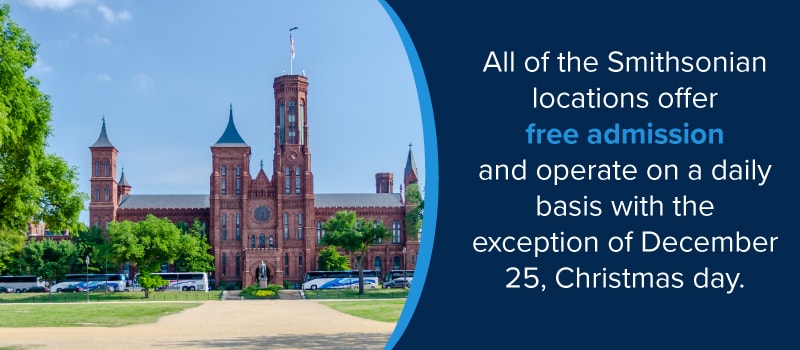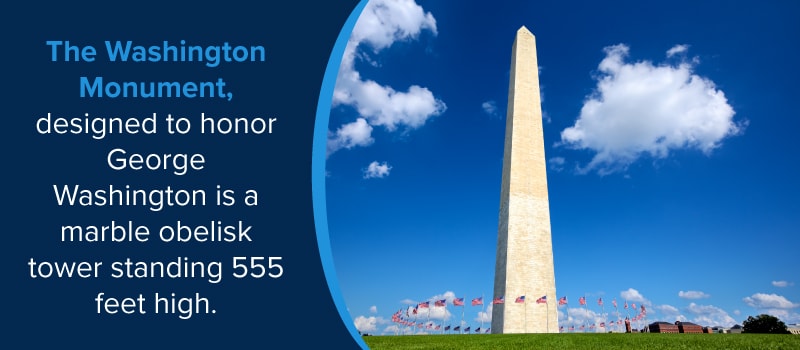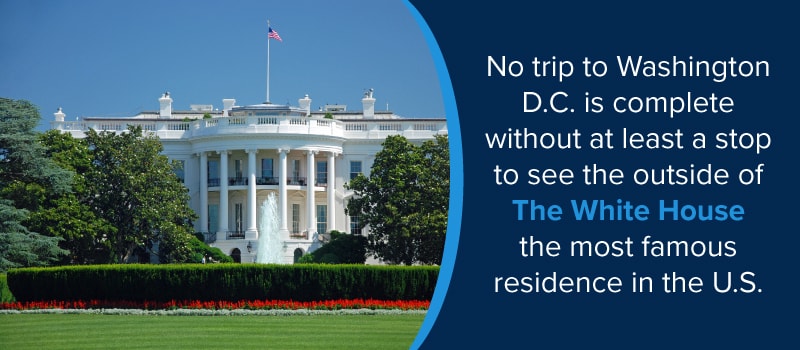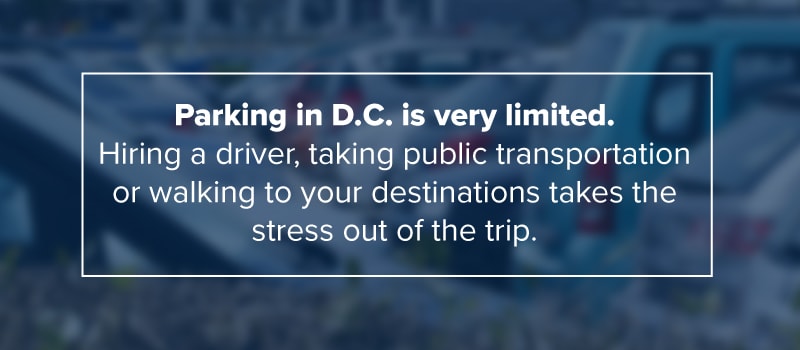Washington, D.C. offers no shortage of things to do, from world-renowned museums to stunningly powerful memorials. It would take weeks or even months to visit all the sites, so narrowing the list down to the top things to do in D.C. helps you hit the highlights.
Along with the best attractions in the city, Washington, D.C. treats visitors to a wide array of amazing restaurants and nightlife options. Whether you’re staying for a few days or a few weeks, be sure to check out these top 10 things to do in Washington, D.C.
1. SMITHSONIAN MUSEUMS
One of the top things to do in Washington, D.C. is to visit one of the 19 D.C.-area Smithsonian locations, including the National Zoological Park. All of the Smithsonian locations offer free admission and operate on a daily basis with the exception of December 25, Christmas day.

If you’re not sure which location to visit, take a quick look at the available options:
- African American History and Culture Museum
- African Art Museum
- American History Museum
- Arthur M. Sackler Gallery
- American Art Museum
- Arts and Industries Building
- Air and Space Museum
- Air and Space Museum Udvar-Hazy Center
- American Indian Museum
- Freer Gallery of Art
- Hirshhorn Museum and Sculpture Garden
- Natural History Museum
- National Zoo
- Portrait Gallery
- Postal Museum
- Renwisk Gallery
- Smithsonian Insitute Building (The Castle)
Start at the Castle known as the Smithsonian Institute Building, which serves as the visitor center for all of the museums and galleries. Here, you can use interactive tools and get help from volunteers to plan your visit to the various Smithsonian locations. The center also offers free Wi-Fi, a café, a store and tours to highlight the grand architecture of the building itself.
Keep in mind that even though the museums offer free admission, you may still end up spending money. Many of the locations offer extra experiences that come with a small fee.
2. TIDAL BASIN
View some of the best monuments in Washington, D.C. from a different angle when you stop by the Tidal Basin. This manmade body of water has been around since the late 1800s as a way to help control the Potomac water levels. Today, the basin serves as a popular place for people to walk, meet and enjoy the views. If you prefer to see the city from the water, rent one of the two-person or four-person paddleboats that operate from May to October.
Whether you paddle or walk around the Tidal Basin, catch a glimpse at these monuments nestled around the body of water:
- Thomas Jefferson Memorial
- Franklin Delanor Roosevelt Memorial
- Martin Luther King, Jr. Memorial
- George Mason Memorial
- John Paul Jones
- Japanese Pagoda
While it isn’t actually on the Tidal Basin, you can also get a clear view of the Washington Monument from the shore or on the water. You can catch a glimpse of the monument’s reflection in the water as well.
One of the most amazing features of the Tidal Basin is the collection of cherry trees along the shore, many of which were part of a gift from Japan in 1912. To see the trees in their full magnificence, visit in early April, when the cherry trees bloom. The National Cherry Blossom Festival runs over four weekends each year in March and April to celebrate the cherry tree gift from Japan and to highlight the beauty of the blooms. The festival includes hundreds of free events, including a parade, fireworks and cultural performances.
3. NATIONAL MALL
The National Mall encompasses a large area of Washington, D.C. that is popular with visitors. The area goes from the U.S. Capitol to the Potomac River and includes a number of memorials, monuments and museums. Many of the Smithsonian locations are located on the National Mall. With over 1,000 acres of green space, the National Mall is a great place to stretch your legs and soak in key sites of the city. Put on your comfy walking shoes, and start exploring.
Some of the highlights of the National Mall include:
- Washington Monument: The monument designed to honor George Washington is a marble obelisk tower standing 555 feet high. Check out the monument from a distance and close up to get the full effect.
- Lincoln Memorial: Another centerpiece of the mall is the Lincoln Memorial, where you can see a larger-than-life marble statue of Abraham Lincoln.
- D.C. War Memorial: This memorial honors those who fought and died during World War I. The memorial consists of an open-air circular design made of marble. The memorial was also designed to serve as a bandstand for concerts serving as a tribute to those who served.
- World War II Memorial: Stop by this memorial to reflect on the sacrifices of those who served in World War II. The memorial features a plaza and fountain surrounded by pillars and triumphal arches.
- Vietnam Veterans Memorial: The Vietnam Veterans Memorial is another highlight of the National Mall. The massive wall features names of those who were killed or missing in action during the Vietnam War. The names appear chronologically. A diamond next to the name indicates the person died, while a cross means they were missing in action.
- Korean War Veterans Memorial: This memorial features a Wall of Remembrance and 19 stainless steel statutes honoring the sacrifices of those who served during the Korean War.

If you’re not sure which location to visit, take a quick look at the available options:
- African American History and Culture Museum
- African Art Museum
- American History Museum
- Arthur M. Sackler Gallery
- American Art Museum
- Arts and Industries Building
- Air and Space Museum
- Air and Space Museum Udvar-Hazy Center
- American Indian Museum
- Freer Gallery of Art
- Hirshhorn Museum and Sculpture Garden
- Natural History Museum
- National Zoo
- Portrait Gallery
- Postal Museum
- Renwisk Gallery
- Smithsonian Insitute Building (The Castle)
Start at the Castle known as the Smithsonian Institute Building, which serves as the visitor center for all of the museums and galleries. Here, you can use interactive tools and get help from volunteers to plan your visit to the various Smithsonian locations. The center also offers free Wi-Fi, a café, a store and tours to highlight the grand architecture of the building itself.
Keep in mind that even though the museums offer free admission, you may still end up spending money. Many of the locations offer extra experiences that come with a small fee.
2. TIDAL BASIN
View some of the best monuments in Washington, D.C. from a different angle when you stop by the Tidal Basin. This manmade body of water has been around since the late 1800s as a way to help control the Potomac water levels. Today, the basin serves as a popular place for people to walk, meet and enjoy the views. If you prefer to see the city from the water, rent one of the two-person or four-person paddleboats that operate from May to October.
Whether you paddle or walk around the Tidal Basin, catch a glimpse at these monuments nestled around the body of water:
- Thomas Jefferson Memorial
- Franklin Delanor Roosevelt Memorial
- Martin Luther King, Jr. Memorial
- George Mason Memorial
- John Paul Jones
- Japanese Pagoda
While it isn’t actually on the Tidal Basin, you can also get a clear view of the Washington Monument from the shore or on the water. You can catch a glimpse of the monument’s reflection in the water as well.
One of the most amazing features of the Tidal Basin is the collection of cherry trees along the shore, many of which were part of a gift from Japan in 1912. To see the trees in their full magnificence, visit in early April, when the cherry trees bloom. The National Cherry Blossom Festival runs over four weekends each year in March and April to celebrate the cherry tree gift from Japan and to highlight the beauty of the blooms. The festival includes hundreds of free events, including a parade, fireworks and cultural performances.
3. NATIONAL MALL
The National Mall encompasses a large area of Washington, D.C. that is popular with visitors. The area goes from the U.S. Capitol to the Potomac River and includes a number of memorials, monuments and museums. Many of the Smithsonian locations are located on the National Mall. With over 1,000 acres of green space, the National Mall is a great place to stretch your legs and soak in key sites of the city. Put on your comfy walking shoes, and start exploring.
Some of the highlights of the National Mall include:
- Washington Monument: The monument designed to honor George Washington is a marble obelisk tower standing 555 feet high. Check out the monument from a distance and close up to get the full effect.
- Lincoln Memorial: Another centerpiece of the mall is the Lincoln Memorial, where you can see a larger-than-life marble statue of Abraham Lincoln.
- D.C. War Memorial: This memorial honors those who fought and died during World War I. The memorial consists of an open-air circular design made of marble. The memorial was also designed to serve as a bandstand for concerts serving as a tribute to those who served.
- World War II Memorial: Stop by this memorial to reflect on the sacrifices of those who served in World War II. The memorial features a plaza and fountain surrounded by pillars and triumphal arches.
- Vietnam Veterans Memorial: The Vietnam Veterans Memorial is another highlight of the National Mall. The massive wall features names of those who were killed or missing in action during the Vietnam War. The names appear chronologically. A diamond next to the name indicates the person died, while a cross means they were missing in action.
- Korean War Veterans Memorial: This memorial features a Wall of Remembrance and 19 stainless steel statutes honoring the sacrifices of those who served during the Korean War.

Before your tour of the White House, familiarize yourself with these tips and rules:
- No video recording devices: You are not permitted to video or live stream inside the White House. You can bring your smartphone or compact camera with a lens under 3 inches to take still photos only
- No phone calls or texting: While your smartphone is permitted, you can’t make phone calls or text while inside.
- <strong• Prohibited items: The White House prohibits several items, such as bags — whether they are purses, handbags or backpacks, food or drink, tobacco products, strollers, pointed objects, aerosol containers, guns, ammunition, fireworks, martial arts weapons, knives of any kind, etc. There are no storage facilities in or near the White House, and you will not be allowed inside if you bring a prohibited item.
- Required ID: Anyone 18 and older must show a government-issued photo ID, such as a driver’s license, military ID or passport. Foreign nationals must show a passport.
- Bathroom access: Make sure you use the restroom before you tour, as there are no public restrooms available at the White House. Make a stop at the Ellipse Visitor Pavilion in the park area just south of the White House for public restrooms.
5. GEORGETOWN
The Georgetown area of Washington, D.C. lets you take a stroll back in time with its historic atmosphere in a picturesque waterfront location. Cobblestone streets punctuate the neighborhood, which includes lots of 18th and 19th century architecture. The area includes a variety of shops and restaurants, serving up food from almost any nationality you can imagine.
When you want a break from the hustle and bustle of D.C., head to Georgetown’s C & O Canal. Walk along the towpath for amazing views of the canal while being surrounded by historical architecture.
If you plan to visit Georgetown on a weekend, prepare for crowds. Make reservations if you have a particular restaurant in mind to save time.
6. U.S. HOLOCAUST MEMORIAL MUSEUM
Take time to visit the U.S. Holocaust Memorial Museum, a living memorial designed to inspire visitors to fight against hate while promoting human dignity. While many of the memorials and monuments in D.C. represent freedom, this museum serves as a reminder of how quickly hatred can take freedoms away.
The museum and memorial covers a sobering topic, but it is an informative and inspirational stop on your D.C. itinerary, with the goal of fueling a sense of moral responsibility.
7. WASHINGTON NATIONAL CATHEDRAL
No matter what your religious beliefs, the Washington National Cathedral offers awe-inspiring architecture and beauty. The Gothic-style cathedral features flying buttresses, intricately designed stained glass windows and gargoyles among other beautiful detailing. Gardens surrounding the cathedral create an idyllic setting for your visit.
If you want to venture inside, the cathedral charges an admission fee Monday through Saturday. The cathedral offers guided tours each day of the week. On Sundays, visitors may enter the cathedral free of charge and participate in 8am worship services. At 4pm on Sundays, catch the choral evensong.
8. U.S. CAPITOL & LIBRARY OF CONGRESS
Whether you love U.S. history or not, a stop at the U.S. Capitol is something you will always remember. If you don’t want to mess with going inside, at least walk by the building to see it for yourself. If you decide to go inside, head to the Capitol Visitor Center on the east side of the Capitol. Here, you can explore Exhibition Hall with many artifacts to tell the story of the United States.
If you want to see areas beyond the visitor center, the only way to do so is through a guided tour. If the Capitol is a must-do on your list, make advanced reservations either online or through your local Representative or Senator. Same-day passes are available, but those passes often go quickly, especially during peak visiting times.
If you visit the Capitol, don’t miss the opportunity to also see the Library of Congress. It takes a quick walk to get there. Inside, you’ll find much more than a library. From the architecture to the historical documents housed inside, this Library of Congress is full of history. Free one-hour tours from Monday through Saturday provide you with information on the architecture, art and history of the building.
9. ARLINGTON NATIONAL CEMETERY
While not technically in Washington, D.C., it’s worth the trip across the Potomac to visit Arlington National Cemetery. In general, vehicles are not allowed inside Arlington, but you are welcome to explore the cemetery on foot. Prepare to go through security before entering the cemetery, even as a pedestrian. Check out the ANC Explorer app for a self-guided tour and to locate specific gravesites or points of interest.
Another option is to take an interpretive tour on a bus through Arlington National Cemetery Tours, Inc. The bus tour stops at the U.S. Marine Corps War Memorial, U.S. Coast Guard Memorial, President John F. Kennedy’s gravesite, Tomb of the Unknown Soldier, U.S. Army General John J. Pershing’s gravesite and the Arlington House, also known as the Robert E. Lee Memorial. On the weekend, the tour also stops at the September 11 Memorial and near sections 55 and 60.
10. INTERNATIONAL SPY MUSEUM
The International Spy Museum gives you a glimpse of history with a different perspective. All of the exhibits in the museum focus on espionage from a worldwide perspective.
This privately owned museum is the only spy museum that looks at espionage throughout history rather than during a particular time or in a particular country. The experience includes films, artifacts and interactive displays to tell real stories about spies from biblical times to today.
TIPS FOR TRAVELING TO WASHINGTON, D.C.
With your list of top things to see in Washington, D.C., you may feel ready to conquer the city. Having an itinerary is a good idea, but understanding how to best navigate the city makes the trip more enjoyable with less stress. Follow these tips for help:
- Don’t drive yourself: Parking in D.C. is very limited. Most of the top sites in the city don’t offer public parking. Hiring a driver, taking public transportation or walking to your destinations takes the stress out of the trip.
- Create a realistic itinerary: You simply can’t see it all in one trip. In fact, you could visit D.C. every year and still find plenty of new things to see each time. Choose the highest priority stops on your list, and give yourself enough time to enjoy them. If you pack every day with nonstop entertainment, you won’t feel like you really get to experience anything.
- Prep for security: Many museums offer free admission, but be prepared to go through metal detectors and bag checks before entering. Pack your bags for easy checking to make it through security faster. Check the restrictions and rules of each site you plan to visit to avoid issues when you enter.
- See the city at night: Everything looks a little different a little more beautiful at night. Take at least one night of your trip to see the memorials, museums and government buildings while they are lit up.
- Consider timing: Summer is a popular time to visit D.C. which means lots of crowds. The heat and humidity also make outdoor activities less enjoyable. Consider a spring or fall trip to D.C. for less crowds and more comfortable temperatures.

Which stops make your top 10 things to do in Washington, D.C.? No matter what they are, your schedule is sure to be packed from the time you arrive until the time you leave.
Eliminate some of the stress of navigating the busy streets of Washington, D.C. by booking transportation with Uptown Bus. Let our professional drivers transport you to the best things to do and see in Washington, D.C. If you’re flying to Washington, D.C., Uptown Bus offers airport transportation to get you to your hotel quickly and easily.